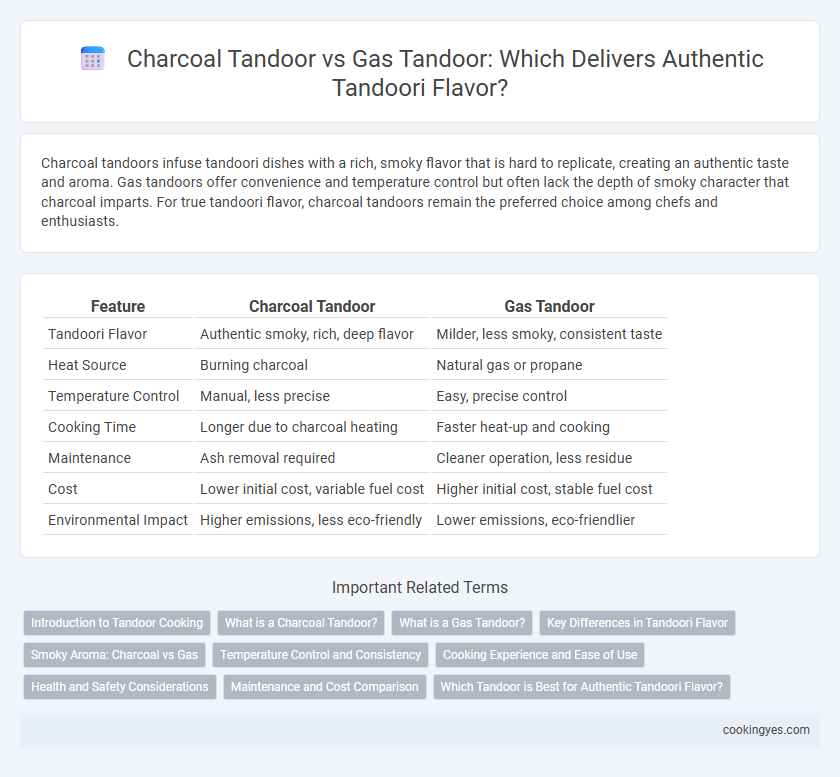Charcoal tandoors infuse tandoori dishes with a rich, smoky flavor that is hard to replicate, creating an authentic taste and aroma. Gas tandoors offer convenience and temperature control but often lack the depth of smoky character that charcoal imparts. For true tandoori flavor, charcoal tandoors remain the preferred choice among chefs and enthusiasts.
Table of Comparison
| Feature | Charcoal Tandoor | Gas Tandoor |
|---|---|---|
| Tandoori Flavor | Authentic smoky, rich, deep flavor | Milder, less smoky, consistent taste |
| Heat Source | Burning charcoal | Natural gas or propane |
| Temperature Control | Manual, less precise | Easy, precise control |
| Cooking Time | Longer due to charcoal heating | Faster heat-up and cooking |
| Maintenance | Ash removal required | Cleaner operation, less residue |
| Cost | Lower initial cost, variable fuel cost | Higher initial cost, stable fuel cost |
| Environmental Impact | Higher emissions, less eco-friendly | Lower emissions, eco-friendlier |
Introduction to Tandoor Cooking
Charcoal tandoors impart an authentic smoky flavor to tandoori dishes due to the high heat and natural smoke generated by burning charcoal, enhancing the unique taste and texture. Gas tandoors offer precise temperature control and quicker heating times but may lack the distinctive smoky aroma essential for traditional tandoori cooking. Understanding the differences in heat source and flavor profiles is crucial for selecting the ideal tandoor that best replicates the classic tandoori experience.
What is a Charcoal Tandoor?
A Charcoal Tandoor is a traditional clay oven fueled by charcoal, generating intense heat and imparting a distinctive smoky flavor essential to authentic tandoori dishes. The charcoal's natural aromatic smoke enhances the marinade's spices, creating the iconic char and crisp texture unique to tandoori cooking. This method contrasts with gas tandoors, which lack the deep smoky essence critical for traditional tandoori taste.
What is a Gas Tandoor?
A gas tandoor is a cylindrical clay or metal oven heated by natural gas or propane, designed to replicate the intense, consistent heat of traditional charcoal tandoors used in Indian cooking. It offers precise temperature control and faster heating times, making it ideal for consistent tandoori flavor without the smoky variations of charcoal. While charcoal tandoors infuse a distinctive smoky aroma into tandoori dishes, gas tandoors provide efficiency and convenience, producing a clean and evenly cooked tandoori style.
Key Differences in Tandoori Flavor
Charcoal tandoors impart a smoky, intense flavor to tandoori dishes due to the natural combustion of wood or charcoal, enhancing the traditional earthy aroma and slightly crispy texture. Gas tandoors offer more consistent heat control, resulting in evenly cooked food but often lack the deep smoky notes characteristic of charcoal-fired tandooris. Key differences in tandoori flavor center around the smoky depth and rustic taste from charcoal versus the cleaner, subtler flavor profile achieved with gas tandoors.
Smoky Aroma: Charcoal vs Gas
Charcoal tandoors infuse tandoori dishes with a rich, smoky aroma due to the natural combustion of wood or charcoal, enhancing the authentic flavor profile. Gas tandoors provide consistent heat but lack the depth of smoky aroma, resulting in a cleaner taste with less charred complexity. The choice between charcoal and gas tandoors significantly impacts the traditional tandoori flavor, with charcoal preferred for its signature smoky essence.
Temperature Control and Consistency
Charcoal tandoors provide intense heat and smoky flavor essential for authentic tandoori dishes, but temperature control can be challenging, often resulting in fluctuating cooking conditions. Gas tandoors offer precise temperature regulation and consistent heat, ensuring uniform cooking while lacking the traditional smoky aroma imparted by charcoal. For chefs prioritizing flavor authenticity, charcoal remains preferred, while gas tandoors excel in efficiency and reliability without compromising cooking precision.
Cooking Experience and Ease of Use
Charcoal tandoors deliver an authentic smoky flavor and high intense heat crucial for traditional tandoori dishes, but they require more time to ignite and careful temperature management. Gas tandoors offer consistent heat control and faster startup, making them easier to use for beginners, though they may lack the deep smokiness imparted by charcoal. The choice between charcoal and gas tandoors hinges on balancing the rich, traditional cooking experience with convenience and ease of operation.
Health and Safety Considerations
Charcoal Tandoors impart an authentic smoky flavor to tandoori dishes but generate higher levels of carcinogenic polycyclic aromatic hydrocarbons (PAHs), posing potential health risks. Gas Tandoors offer a cleaner combustion process with lower emissions of harmful pollutants, enhancing safety for both chefs and diners. While charcoal provides traditional flavor profiles, gas tandoors ensure improved air quality and reduce fire hazards in commercial kitchens.
Maintenance and Cost Comparison
Charcoal tandoors deliver authentic smoky flavors essential for traditional tandoori cooking but require frequent cleaning of ash and soot, increasing maintenance efforts. Gas tandoors offer easier temperature control with minimal residue buildup, resulting in lower upkeep and faster cleaning times. While charcoal tandoors have lower initial costs, gas tandoors prove more cost-effective over time due to reduced fuel expenses and maintenance demands.
Which Tandoor is Best for Authentic Tandoori Flavor?
Charcoal tandoors deliver an authentic tandoori flavor by infusing smoky aromas and intense heat that sear marinated meats, preserving juiciness and enhancing spices. Gas tandoors offer precise temperature control and cleaner combustion but lack the natural smokiness crucial for traditional tandoori dishes. For genuine tandoori flavor, charcoal tandoors remain the preferred choice among chefs and culinary experts.
Charcoal Tandoor vs Gas Tandoor for tandoori flavor Infographic

 cookingyes.com
cookingyes.com